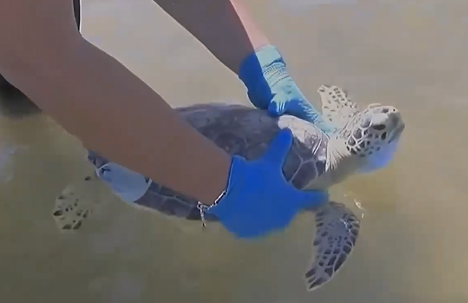Turtle Talk: Gulf Center for Sea Turtle Research Releases Three Green Sea Turtles
By Caroline Jordon
Tweet
Algernon, an adolescent green sea turtle, prepares a deep breath before splashing the team when he swims away.
On March 25, Gulf Center for Sea Turtle Research (GCSTR) staff and volunteers gathered along the Texas Parks and Wildlife boat ramp in Freeport, Texas, to release three green sea turtles.
Dr. Christopher Marshall, Professor of Marine Biology at TAMUG and Director of the GCSTR, was one of the attendees and was proud to announce the inclusion of these turtles in their research program, indicating how previously attached acoustic tags would allow this to happen.
All three of these sea turtles were brought into the hospital following cold stun events in January and February 2022, when the sea temperatures fell below 50 degrees. When these events happen, the turtles become lethargic and are unable to survive without human intervention.
Three of the rescued turtles on those “stunningly” cold days include Algernon, James Bond, and Paisley. Algernon, named for his extensive algae coverage on his shell, and James Bond, with identification number 007, were two of the rescued turtles from the January cold stun event. A month later, Paisley, the smallest of the three, was rescued from the February cold stun event.
Theresa Morris, program assistant for the hospital and main rehabilitator, recounted that while Paisley came in with a good bill of health due to her small size, Algernon came in bearing a “significant head injury where its skull was exposed.” James Bond was also in bad shape upon arrival, thoroughly emaciated and covered in Fibropapillomatosis or “FP” tumors, a common and easily communicated disease among sea turtle populations.
When it came time to release these sea turtles, Paisley (hospitalized for 47 days), Algernon (62 days), and James Bond (62 days) could be heard swiping their front flippers against their transport bins, eager as the rest of us for the moment staff have been working diligently towards. One at a time, the turtles were released, thrashing their flippers excitedly once catching a glimpse of the clear seawater ahead of them.
Eliza Perez, an active volunteer for the GCSTR and student at TAMUG had the chance of a lifetime and described how releases remind her of the purpose of her work both in the hospital and by the water.
Smiles were contagious as release teams of three waded in the cool shallow bay, blue latex gloves on, and gripping the turtle's shells as they swam eagerly through the air. Perez described getting to bring Algernon out to the water as a “truly amazing experience”. Once hands let go, each turtle made the same getaway exit straight to the left, nearly running into team members each time. After a couple deep breaths of air, head poking through the water, each turtle thanked their rehabbers and rescuers before darting off to a future that wouldn't have been possible without them.
Once nothing but a campus supply shed, the temporary GCSTR hospital building sits on the edge of Pelican Island as one of the first buildings on the left to greet students and staff from the bridge. Though, most that pass by are unaware that there is a functioning sea turtle hospital inside.
This article is the first in a series about the GCSTR we’re calling “Turtle Talk.” Disclosure: The author of this article was a student participant in the sea turtle release.
![]()
More:
News